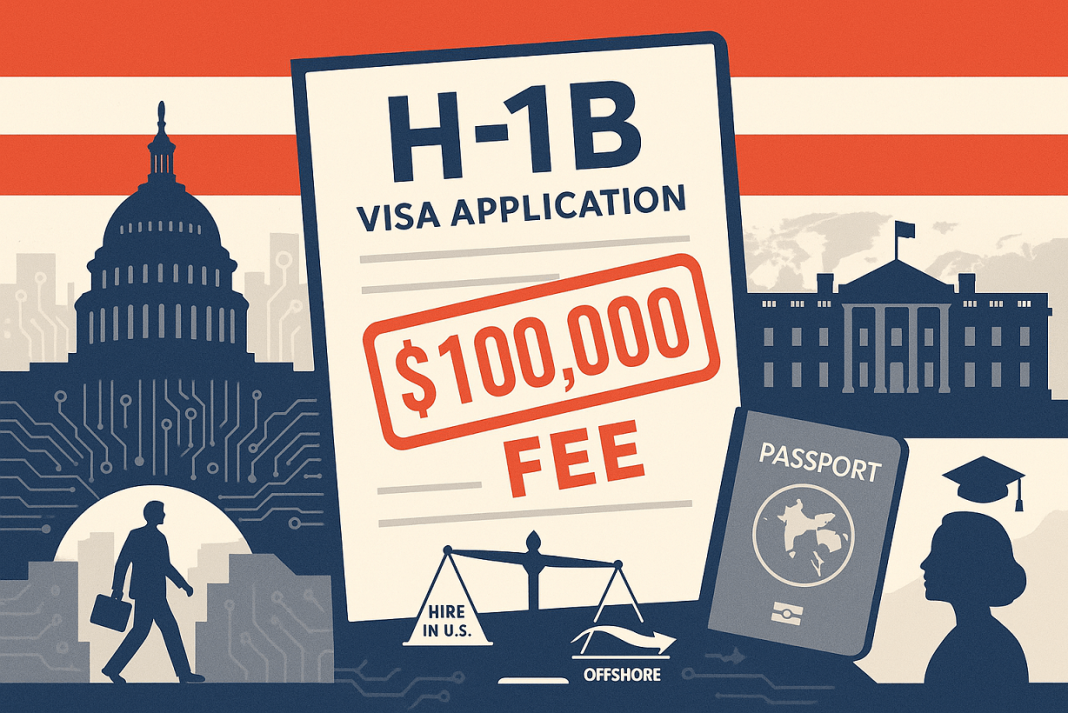The White House has moved to overhaul the H-1B system by attaching a $100,000 yearly charge to each sponsored worker. Analysts say the policy could reshape hiring in the technology, finance, and consulting sectors.
United States President Donald Trump signed a proclamation in Washington on September 19, 2025, introducing a $100,000 fee per year for companies sponsoring H-1B workers. The administration presented the charge as part of a broader shift to prioritize domestic hiring and to narrow use of the high-skill visa in entry-level roles.
Officials familiar with the plan said the fee is intended to be annual, with discussions indicating it would apply to each of the visa’s first three years. The White House and agency lawyers are still finalizing implementation mechanics, including how the payment is paired with existing filing and fraud prevention charges.
While the text of the proclamation targets new and pending cases, companies were told the change could begin as early as 12:01 a.m. EDT on September 21, 2025. Some employers advised foreign staff to avoid international travel until formal guidance lands, a precaution that has become familiar in prior immigration overhauls.
What Changes For Employers
The H-1B program allocates 65,000 visas annually, with a separate pool of 20,000 for holders of US advanced degrees. Most costs are already borne by sponsoring employers. Adding a six figure yearly charge would multiply total outlays, especially for firms that sponsor large cohorts of engineers and analysts.
For startups, recruiters say the calculus shifts fastest. A single hire could carry hundreds of thousands in additional liability over a standard three year period, which might nudge founders to build teams offshore or to delay roles that depend on niche skills.
If you are going to train somebody, train one of the recent graduates from one of the great universities across our land. Train Americans, stop bringing in people to take our jobs.
Legal Questions, Market Impact
Immigration lawyers were quick to flag a threshold issue, namely whether the executive branch can set fees far beyond cost recovery without new legislation. Congress typically authorizes agencies to collect amounts tied to adjudication and service delivery. Any immediate court fight would likely focus on statutory authority and administrative procedure.
Markets reacted in real time. Shares in companies that rely heavily on contract IT labor slipped, and investors voiced concerns that the additional levy could accelerate the relocation of high value projects to lower cost hubs abroad. Supporters of the proclamation countered that companies will still pay where a role is truly specialized, and, in their view, that is the point.
Who Is Most Affected
The technology sector sponsors the largest number of H-1B workers, although healthcare, finance, and higher education also rely on the category. Recent government data shows India accounts for the majority of H-1B beneficiaries, with China a distant second, which means the new fee will be felt most in corridors that connect California, Texas, Washington state, and New York to Bengaluru, Hyderabad, and Shanghai.
The timing adds uncertainty for recent graduates on F-1 visas who were counting on H-1B status after optional practical training. University advisors say they are fielding fresh questions on whether to pivot to roles outside the US or to consider intra company transfers into Canada or the UK, where work visa fees are high but still far below the new US figure.
Alongside a New “Gold Card”
The proclamation arrived alongside a separate announcement of a so called “gold card” option, described by officials as a path to US permanent residence tied to a seven figure payment. That program targets investors and ultra high earners, and it underlines the administration’s preference for screening by price within legal migration streams.
To be sure, the H-1B overhaul is the headline. If the $100,000 charge survives scrutiny, it would redefine the cost of hiring foreign talent in America, potentially for years.
